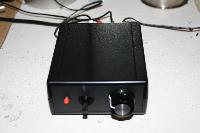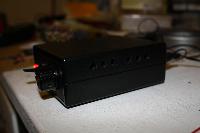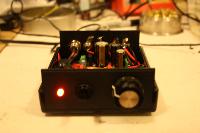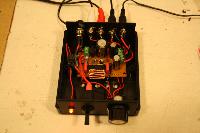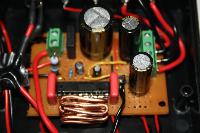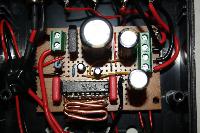GoatAmp amplifier
Overview
The GoatAmp is a low power amplifier built around a single integrated circuit, making it a "chip amp" (as opposed to one built using vacuum tubes or discrete semiconductors). The chip in question is the TPA1517 by Texas Instruments. It can put 6W per channel into 4 ohm loads at 10% THD, and 3W at 0.2% THD. It's not hi fi, but it's cheap, simple, still sounds pretty good and gets plenty loud enough with high sensitivity speakers.
Photos
Details
Volume control is implemented by a 10K logarithmic taper dual potentiometer.
Power is connected via a standard 2.1 x 5.5 mm barrel plug.
Input and output are both via RCA jacks. Using these for input is standard, but they are unusual for output, which is usually done via binding posts. This is because I built the GoatAmp to power two cheap speakers I picked up from a thrift store, which unusually have RCA plugs at the end of their input leads.
The GoatAmp is powered from a 12V AC "wall wart" (aka "plug pack"). This is rectified by a diode bridge and smoothed by a large capacitor. The final DC voltage is about 16.5V (slightly higher than you may calculate, because the transformer is not fully loaded). The recommended voltage range for the TPA1517 is 9.5V - 18V, with an absolute maximum of 22V, so I'm within specs. While testing the chip on a breadboard, I used a 12V regulated supply, which worked just fine. I found that the chip got a lot hotter running from the higher voltage, so keeping the voltage at 12V is probably a good idea for situations where heat dissipation is difficult. Because the GoatAmp doesn't have a regulator in it, it should also work just fine if powered from a 9V or 10V AC wall wart.
Because the TPA1517 runs a little hot at 16.5V, I had to implement some heat sinking. 11 pins on the chip (including one whole side of it) are heat sink pins, the idea being that if you are etching a PCB for your device you connect these pins to a large copper plane. Since I used protoboard I did not have this choice. Pre-made heat sinks for DIP20 ICs are fairly hard to find, and not super-effective (the plastic material enclosing the chip has poor thermal conductivity), so I improvised. I soldered a length of heavy gauge copper wire along the heat sink pins of one side of the chip and twisted it into a three dimensional radiator shape. There are ventilation holes in the bottom of the enclosure and along the top of the sides, to allow convection. This arrangement seems to work quite well. The TPA1517 has built in thermal protection and will shut down if gets hot enough to damage itself, and this never happened to me even without the little heat sink - my main concern was not keeping the chip alive, but preventing the big electrolytic capacitors from getting too hot. At high temperatures, the electrolyte in these will dry out (over some years) and their capacitance will drop. Keeping electro caps as cool as possible is a good idea for long device life.
The output capacitors combine with the impedance of the speakers to form a first-order passive RC high-pass filter. The corner frequency (which is attenuated by 3db) is given by 1 / 2piR*C, which basically means you want your caps as large as possible to avoid poor bass performance. From this perspective, the 820uF caps I have are a bit small, yielding a corner frequency of 48.5 Hz with 4 ohm speakers, which is well within audible range. I was basically forced into this compromise by my small protoboard. I actually bought a 4700uF power supply smoothing cap and two 2700uF output caps, but there was no way these would all fit, so I was forced to use one of the 2700uF caps for smoothing, and the 820uF caps were the largest pair I had available to fill in. If you have the room, it would be good to aim for about twice that size. However, it's worth noting you'll never get amazing bass from the TPA1517 anyway, at least not without a lot of equalisation - figure 16 on the datasheet shows that the chip has an internal high pass filter, and that gain is down by about 3db somewhere between 40Hz and 50Hz.
How does it sound? I am absolutely not one to write a long subjective review of audio equipment in terms of subjective buzz words that don't really mean anything. Is it warm or cold, clinical or musical, veiled or authoritative, woolly or bright? I don't even understand what most of those words are meant to mean. The TPA1517 sounds good to me. It certainly gets more than loud enough. I expect my cheap speakers contribute more distortion than the amp. Academically, I know that the low power rating means there is not a lot of headroom, and when music with good dynamic range is played on the loud side there must be some clipping going on, but I can't say it's bothered me yet. Despite the small output caps the bass feels nice and full, but then I'm not not one of those "bass people" and I certainly haven't played any dubstep or the like through the GoatAmp.
Schematic
Coming soon. Ish. Maybe. The audio part is just the one given in the datasheet (without the mute switch), the power part is just a bridge rectifier followed by one filter cap, perfectly standard. The input caps are between the volume potentiometer and the chip. If you do it the other way around (pot between caps and chip), you'll have worse impedance matching and I suspect you'll also get some DC flowing from the chip's biased inputs to ground through the pot, which will cause scratchy sounds when you turn the volume knob.
Bill of Materials
- 1 x Bridge rectifier
- 1 x 27000 uF electrolytic capacitor (smoothing cap)
- 1 x TPA1517NE stereo amplifier chip
- 1 x 10kohm resistor (mute/standby override)
- 1 x 1 uF electrolytic capacitor (power supply bypass)
- 1 x 2.2 uF electrolytic capacitor (improved supply voltage ripple rejection)
- 2 x 0.47 uF film capacitors (input caps)
- 2 x 820 uF electrolytic capacitors (output caps)
- 4 x RCA jacks
- 1 x 2.1 mm barrel
- 1 x SPST toggle switch (Carling Technologies DA100-PB-B)
- 1 x red indicator LED
- 1 x 560 ohm 1W resistor (LED current limiting)
- 1 x 10K logarithmic taper potentiometer (volume)
- 1 x PacTec LH45-175 black enclosure
Other DIY TPA1517 resources
The TPA1517 doesn't seem to be a very popular/common chip in the English-speaking DIY world, and you won't find a great deal about it at places like diyaudio.com. However, it does seem to have a strong following in Japan, and I found the following resources. Naturally, these all look a lot nicer than the GoatAmp. Regulated supplies and dual mono bridged configurations seem to be popular.
- Nabe's "TPA1517 Speaker Amp" (a lot of other Japanese TPA1517 pages refer to Nabe-san, so I think maybe this project started a trend)
- Jikomannzoku Audio "TPA Speaker Amp Kit"
- Mia's "Desktop Amp"
- Another page by Mia (seems to be mainly discussing the power supply)
- Musicsys' amp
- Odicyan's amp
- Bonsai Audio's build (seems to include some measurements of the end product)
I also found this Russian page:
If you've built a TPA1517 amp and written about it online, feel free to let me know about it and I'll put a link here.
